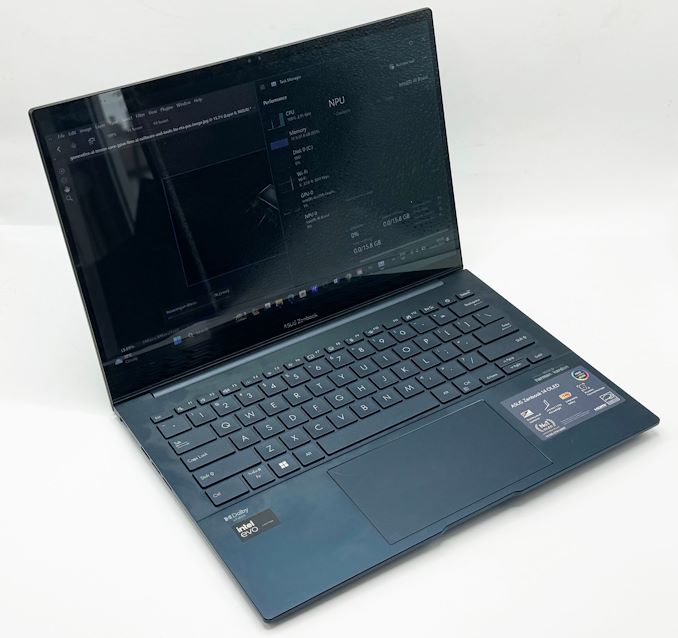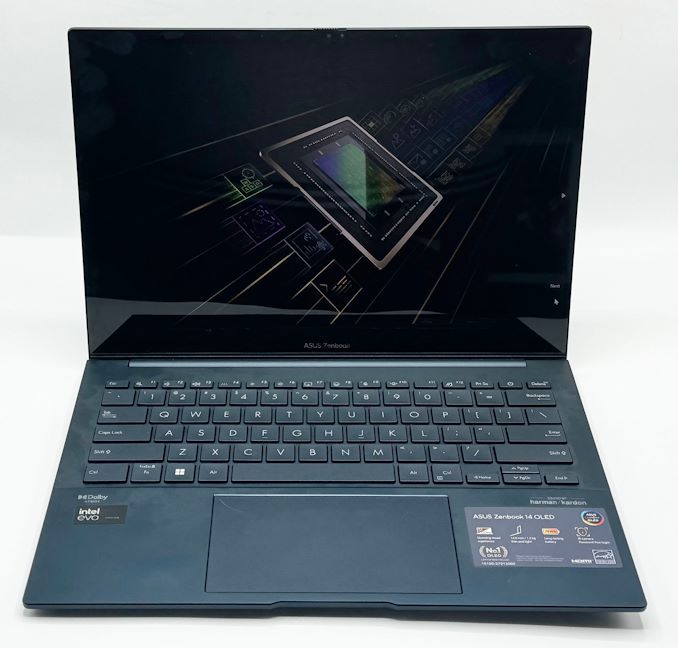The Intel Core Ultra 7 155H Review: Meteor Lake Marks A Fresh Start To Mobile CPUs
by Gavin Bonshor on April 11, 2024 8:30 AM ESTASUS Zenbook 14 OLED UX3405MA: Closer Look
The ASUS Zenbook 14 OLED is one of Intel's EVO-certified notebooks, offering plenty of style and substance within the thin 14.9 mm chassis. While ASUS hasn't provided information on what the chassis is built from, it does look and feel like an aluminum chassis, which doesn't feel particularly cheap and looks the part. As with the rest of the chassis on the ASUS Zenbook 14 OLED, the lid is made from the same aluminium-like material, and it looks very stylish with the Ponder Blue color.
At 312.4 x 220.1 x 14.99 mm (W x D x H), it's portable. The inclusion of the 14-inch 2.8K OLED display and a total weight of just 1.28 kg (2.82 lbs) makes it very capable for its size, as well as a very lightweight offering to travel with. For comparison, the Apple MacBook Air 13-inch (M3) weighs just 0.04 kg less.
Opening up the traditional clamshell design, we can see the 14-inch OLED panel dominating the top half, with the keyboard and the centrally located island-style trackpad. The trackpad doesn't have any discrete buttons, and instead is entirely touch-based. The keyboard keys themselves have a shallow key press and combine the cursor arrows with the (Fn) key functionality while offering a subtle white backlight behind the keyboard, making the Zenbook 14 OLED 'pop.' Although ASUS doesn't include a dedicated fingerprint scanner, along the top of the panel's bezel is a 1080p webcam with a privacy shutter with support for Windows Hello, which can be configured to provide IR face recognition without needing a PIN.
Touching on the display, with a 2.8 K (2800 x 1800) OLED panel, it's fair to say that with the brightness turned up, it's very vibrant and colorful, to say the least. The 14-inch display, according to the official specifications, has a peak brightness of 500 nits when using HDR, while it has a 400 nits peak brightness when HDR is turned off. It can cover 100% of the DCI-P3 color gamut, with a 0.2 ms response time. Regarding refresh rate, the panel supports 120 Hz, while ASUS allows users to switch between either 60 Hz or 120 Hz operation. The panel also has a capacitive touch layer, and ASUS includes a stylus within the packaging for this model.
Looking at the I/O on the ASUS Zenbook 14 OLED, ports and connectors are on both sides of the chassis. Focusing on the left side, it offers a single USB 3.2 G1 Type-A port towards the fold. Three ports look like connectors, but these are just ventilation gaps for airflow to escape.
On the right side are two Thunderbolt 4-capable USB Type-C ports, which support external displays and offer USB power delivery (USB-PD) capabilities. The Zenbook 14 OLED doesn't have a dedicated connector for charging, and instead relies on carging through its USB Type-C ports, with ASUS including a 65 W AC Type-C charger in the box. Also on the right-hand side is a single HDMI 2.1 video output and a single 3.5 mm combo audio jack. ASUS includes a USB Type-A to Ethernet adapter in the box, which I haven't seen for a while.
Overall, from looking at and considering the feel of the ASUS Zenbook 14 OLED UX3405MA, it's certainly a quaint premium 14-inch ultrabook. The bottom-mounted Harmon Kardon linear speakers, which don't look much, sound great and are certainly better than typical stock speakers. There's also the 14-inch OLED screen, which looks great and is vibrant and crystal clear, as expected from an OLED panel.
With a price tag (as configured) of $1299, the ASUS Zenbook 14 OLED UX3405MA is certainly a capable offering, which is powered by Intel's latest Core Ultra 7 155H Meteor Lake SoC, but style and design are one element; performance is perhaps the most important element.
ASUS Zenbook 14 OLED UX3405MA: Software
Before we examine the performance, we'll quickly examine the software bundle supplied. Everything on the ASUS Zenbook 14 OLED revolves around the MyASUS software, which acts as a centralized hub for functionality, profiles, updating drivers/software, and customization.
The MyASUS software has many different device settings that users can customize, such as enabling battery care mode, which limits battery charging beyond 80% immediately. Users can also select between three different fan profiles, including performance mode, which maximizes performance, although this does mean the notebook runs very loud. The other options include standard mode, which dynamically adjusts based on the temperatures, and whisper mode, which is very useful for watching moves in bed.
There are also many display-related options, including allocating more system memory to the integrated Arc Xe graphics and different visual profiles to select from depending on the task. Overall, there are plenty of functionalities within the MyASUS software hub, and having it all within a unified piece of software makes things much better for the overall user experience.


























69 Comments
View All Comments
Ryan Smith - Thursday, April 11, 2024 - link
Hmm, interesting. We're going to have to double-check with Intel on that.Ark has it down as 8 GPU cores. However the official presentation from the December "launch" had it down as 7: https://images.anandtech.com/galleries/9400/Intel%...
It's not uncommon for Intel presentations to have errors. But they also crop up in Ark from time to time as well. So 8 is probably correct, but we should get confirmation just in case. Reply
meacupla - Friday, April 12, 2024 - link
Yeah, I only noticed the difference when I had to look up why MSI claw was using a 135H. ReplyRyan Smith - Friday, April 12, 2024 - link
And Intel has since confirmed it to be 8. The article (and past articles with the bad info) have been updated. Thanks for pointing that out, meacupla! ReplyThe_Assimilator - Thursday, April 11, 2024 - link
An entire page, and an entire paragraph in the conclusion, wasted on pointless AI nonsense. Nobody reading this site cares about that rubbish, stop wasting our time. ReplyThe_Assimilator - Thursday, April 11, 2024 - link
Also good to see Intel's "revolutionary" new chip pulling the exact same BS as their past chips have regarding power. "28W" that actually uses 65W, incredible. Replymode_13h - Monday, April 15, 2024 - link
The only thing your comment tells me is that the AI benchmarks should be updated to include more typical real-world AI usage examples. Aside from things like Stable Diffusion, where most readers are likely to encounter AI in their everyday computing is in apps like video conferencing (background replacement, noise suppression) and photo editing. ReplyNextGen_Gamer - Thursday, April 11, 2024 - link
Those iGPU numbers are way off - the Socket AM5 8700G is obviously going to outperform the mobile variant across the board, based on TDP alone. Even if the mobile version was using LPDDR5X memory (which in this case it wasn't), it wouldn't be enough to close the gap.AnandTech: ever given any though to getting all these chips in mini PC form? Most of those allow much more control over the TDP, along with memory/SSD being your own picks. And then that all but eliminates the cooling issues of a laptop. Reply
meacupla - Thursday, April 11, 2024 - link
While you can get a 7940HS miniPC now, Core Ultra miniPCs aren't out yet.Core Ultra laptops are showing up at reviewers just now, but they've barely left the gate in terms of availability to regular consumers.
Asus announced NUC 14 two weeks ago, on Mar 27. They are just now being listed at various retailers, so I would expect them to show up in stock a month or two from now. Reply
ricebunny - Friday, April 12, 2024 - link
My retailer indicates that the Asus Nuc 14Pro+ is available. I would be curious to see how the 155H performs in that chassis with a lot more thermal headroom. Replyhaplo602 - Thursday, April 11, 2024 - link
"On the flip side, as we established with our look at power consumption, the Ryzen 9 7940HS laptop is able to sustain a much higher TDP overall – so that memory bandwidth deficit is counterbalanced by a sizable TDP advantage."Are you really a tech review site ? In this case memory bandwidth is king with TDP a distant second (given comparable compute power). And Intel has a huge advantage with LPDDR5X here that it manages to waste somehow.
Also the official title is CPU review and there are graphs for BATTERY CHARGE TIME ??? Really ? What does that have to do with the CPU at all ? Reply